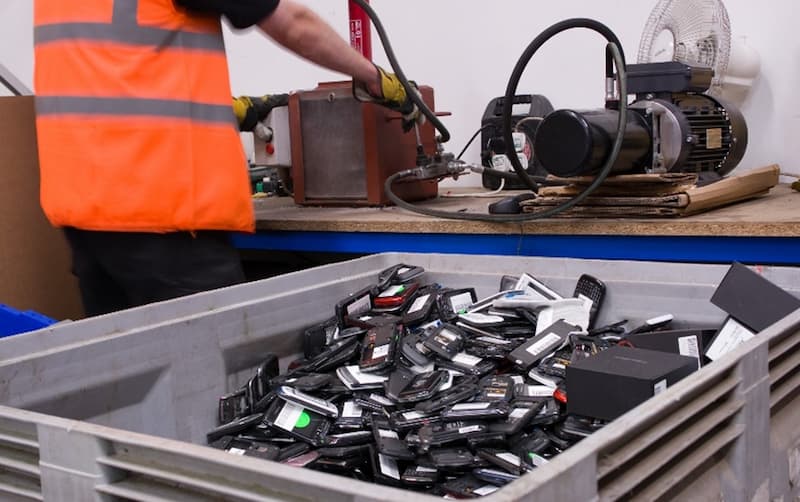What Opportunities Does E-Waste Disposal Provide?

Continuous advancement of IT and phone technology brings an unfortunate consequence: a concurrent surge in e-waste. Older devices quickly become obsolete for businesses as new technologies become more sophisticated and desirable for daily processes.
It is crucial that alongside these advancements, businesses prioritise responsible equipment disposal and e-waste management to mitigate the environmental impact. This sustainable use of electronic resources is possible whilst not denying ourselves the latest technological innovations. This can be achieved through responsible IT asset disposal. Read on to discover the benefits and opportunities of the latest sustainable e-waste disposal methods.
Global State of E-Waste
Global e-waste statistics have shown an astounding 59.4 million metric tonnes of electronic waste was estimated globally in 2022, projected to increase to 61.3 this year. To put that figure into context, that’s like discarding approximately 1,100 laptops every second for the year. In just one year, an average city would produce around 3,700 metric tonnes of electronic waste, equivalent to the weight of more than 800 elephants. This waste can significantly burden the environment and public health if not managed responsibly.
Unfortunately, only a few IT asset disposal companies will conduct effective and sustainable disposal, while others will contribute to landfills, incineration and other environmentally harmful options. The continued projections see e-waste totals continuing to escalate from our current projection of 61.3 million metric tonnes to 74.7 by the end of the decade. This makes it more vital than ever for businesses to commit to a sustainable corporate IT disposal program to stop this increase and protect our futures.

Can E-Waste Be Disposed Sustainably and Securely?
Yes, it can. Along with our hard drive destruction, we also offer sustainable data shredding that aligns with GDPR standards. Our eco-friendly processes ensure complete and irretrievable destruction of data-bearing devices before sustainably disposing of the physical media it was stored on. All our processes are connected to our commitment to sustainable initiatives.
Waste hierarchy: This emphasises the need to prioritise methods for waste prevention, followed by preparing for reuse/repair, recycling, and recovery. Landfill disposal is the last option for most disposal companies, but we operate with a zero-landfill tolerance policy, with all our available components either reused, remarketed or recycled.
Circular economy: This promotes a regenerative and restorative economic system that minimises waste by promoting reuse and conserving resources. Within a circular economy, products are designed to last longer and be repaired instead of disposed of to reduce waste and promote sustainability. Our popular business phone repair service is a good example of how effective repairing broken or end-of-life items is for building a circular economy.
Circular Computing: This is an initiative that focuses on sustainable IT recycling. This process helps reduce electronic waste by refurbishing and remanufacturing old laptops. In addition, the initiative plants five trees for every laptop sold, thus promoting afforestation and environmental sustainability.
Environmental and Economic Opportunities with Responsible IT Disposal
This growing e-waste problem presents new opportunities for companies to take charge of their environmental impact by embracing sustainable practices such as selling their old IT equipment and phones for repurposing and recycling.

Resource Conservation
E-waste contains many materials, including precious metals like gold, silver, copper, and high-quality plastics. Recycling these materials conserves natural resources and reduces the environmental impact of mining and manufacturing processes. Additionally, by recycling electronic devices, businesses ensure the conservation of valuable resources and reduce the demand for raw materials, reducing future equipment costs long-term.
Environmental Preservation
Proper e-waste disposal prevents harmful substances from polluting the environment. Electronic devices often contain hazardous materials, such as lead, mercury, and brominated flame retardants. If not handled properly, these substances can leach into soil and water sources, posing risks to human health and ecosystems. Choosing to responsibly disposing of e-waste, businesses prevent the release of these harmful substances and contribute to environmental preservation.
Green Company Reputation
Our services, such as sustainable IT asset disposal, significantly impact your company’s environmental stance. Disposing of your IT assets in a sustainable process demonstrates your commitment towards reducing e-waste and minimising the carbon footprint left by your business operations. Your customers will appreciate your commitment to sustainable business practices, leading to increased customer loyalty and a positive brand image.
Sustainable IT Disposal at ICT Reverse
At ICT Reverse, we take pride in our commitment to sustainability. We maintain our various accreditations through close collaboration with the Environmental Agency and regular audits, demonstrating our compliance with environmental regulations with our various IT asset disposal services.
Contact us today to discover how we will help your business embrace these opportunities and grow sustainably for years to come.
